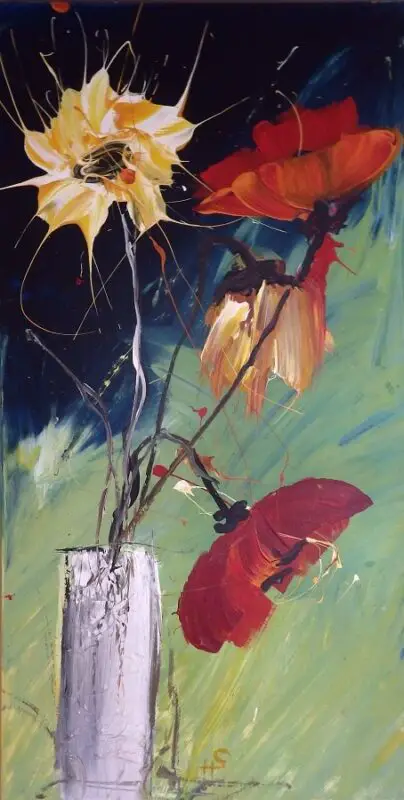Artists who enjoy using acrylic paint appreciate its many benefits. Acrylic paint offers similar color brilliance to watercolor paint and the same incredible density as oil paint. It’s a popular choice because it’s water-soluble and dries relatively quickly.
If you have just created a painting using acrylic paint, you might wonder if you can polish it to retain the intense colors and protect it.
You can polish acrylic paint if you use varnish, which comes in various finishes. Your painting needs to be completely dry before you apply the varnish, and you should consider applying an isolation coat if you plan on removing the varnish in the future.
So, let’s talk about the best ways to polish acrylic paint with this article Can You Polish Acrylic Paint? The Facts Explained.
Table of Contents
How Do I Polish Acrylic Paint?
Artists know that dried acrylic paint is softer and more flexible than oil paint, making it attract more dust and dirt. Placing glass over your painting protects it from dust, but it doesn’t prevent sun damage and the colors from fading.
is softer and more flexible than oil paint, making it attract more dust and dirt. Placing glass over your painting protects it from dust, but it doesn’t prevent sun damage and the colors from fading.

Polishing acrylic paint with varnish adds incredible shine to a painting, intensifies the color, and can protect it from UV damage , dust, dirt, fading, and yellowing. So, what’s the best way to polish acrylic paint?
, dust, dirt, fading, and yellowing. So, what’s the best way to polish acrylic paint?
You can polish acrylic paint using varnish, typically a solvent and resin mixture that you can apply to a dry painting. Varnish protects your artwork from dust, dirt, and UV damage and gives it your desired sheen level.
I’ll explain in more detail below how to polish acrylic paint:
Choose Your Finish
If you paint with acrylics regularly, you might already have one or more products to polish your painting.
Before polishing your acrylic painting, you should decide what type of finish you want. Depending on the nature of your painting, you can opt for any of the following finishes:
- High gloss
- Satin
- Matte
- Something in between that you can create by combining varnishes
Ensure That Your Painting Is Dry
After you’ve decided on the finish you’d like, you can start polishing your painting. Before doing so, ensure that it’s 100% dry before starting. If you apply the varnish to your paint before it’s dry, you risk creating streaks and blending the varnish with the wet paint.
Thankfully, acrylic paint dries pretty quickly, so you’ll likely only need to wait about 24 hours if you’ve just finished your painting. However, you might consider waiting longer to be on the safe side.
Apply an Isolation Coat
After applying varnish to acrylic paint, you can remove it with a solvent, which could damage the underlying paint. Applying an isolation coat protects your painting from the solvent when removing the varnish and allows the varnish
protects your painting from the solvent when removing the varnish and allows the varnish  layers to dry evenly.
layers to dry evenly.
Before applying the isolation coat, test a hidden piece beforehand (this could be on a painted section behind the painting). You can apply the isolation coat once you’re confident that it will work well on your acrylic paint.
Before adding the coat, gently wipe your painting with a lint-free cloth to remove any dust or dirt that could become trapped under the isolation coat.
Follow the instructions on the bottle and add the required amount of water. You usually only need one isolation coat layer, but you’ll need to let it dry for at least 24 hours before applying the varnish.
Apply One or More Layers of Varnish
Varnish comes in a spray or brush-on form. Spray-on varnish is ideal for highly textured paintings, but a brush-on product works well with smooth paintings.
If you’ve opted for a spray-on varnish, ensure there’s plenty of ventilation in the room. For a brush-on application, use a clean synthetic soft-bristled brush and decant the varnish into a shallow container to give you more control over how much product you put on the brush.
If the room gets quite dusty or you have pets, consider placing a cardboard box around the painting to prevent dust or animal hair from sticking to the wet painting.
You will probably have to add some water to the varnish but be sure to follow the instructions on the label carefully for the correct ratio.
If you’re spraying on the varnish, prop the painting up vertically so that the product doesn’t pool over the image. When brushing on varnish, however, lay it flat on a table so that it’s easier to apply.
To prevent the varnish from dripping over the sides of your painting, start varnishing in the center and work your way outwards. Create gentle, left-to-right strokes, taking care not to leave any visible streaks.
After you’ve varnished the entire painting, it can be tempting to go over imperfect areas, but you should avoid this. You risk combining the dried acrylic paint with the wet varnish and creating a mess.
Depending on the sheen and level of UV protection you’re aiming for, you might have to apply more than one coat. Remember that it’s better to apply several thin varnish layers than one thick layer as it will dry faster and give you a more even finish.
Allow the varnish to cure before you apply another layer.
Allow To Dry for Two Weeks
Once you have applied the varnish to your painting, allow it to dry for two weeks. That may sound like a long time, especially since your painting will probably feel dry after a day or two, but it needs two weeks to cure completely.
Once the two weeks are up, your painting should have your desired sheen, and you can hang it up and display it.

Another Way To Make Your Acrylic Paint Shine
If you want to make your acrylic paint shine without varnishing it, you can always use a glossy paint medium. However, this medium will not protect the paint from dust and light damage like varnish will, so you may want to coat it with varnish anyway.
However, mixing in some glossy medium with your paint is an easy way to add extra shimmer and shine to your paintings without requiring much effort.
Final Words
Polishing your acrylic painting with varnish adds shine and protects it from dust and UV damage. Here’s the best way to polish an acrylic painting:
- Select your finish (high gloss, satin, matte, or a combination).
- Ensure that your painting is 100% dry.
- Apply an isolation coat.
- Apply one or more layers of varnish.
- Allow the varnish to cure for two weeks.

Sources
- YouTube: Opus Art Supplies – How to Varnish an Acrylic Painting
- Golden Artist Colors, Inc.: Isolation Coat

- Liquitex: what is acrylic paint?

- Paint & Coatings Industry: Why Does the Sun Damage Paint?



